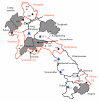A stratified random survey of the proportion of poor quality oral artesunate sold at medicine outlets in the Lao PDR - implications for therapeutic failure and drug resistance
- PMID: 19638225
- PMCID: PMC2734859
- DOI: 10.1186/1475-2875-8-172
A stratified random survey of the proportion of poor quality oral artesunate sold at medicine outlets in the Lao PDR - implications for therapeutic failure and drug resistance
Abstract
Background: Counterfeit oral artesunate has been a major public health problem in mainland SE Asia, impeding malaria control. A countrywide stratified random survey was performed to determine the availability and quality of oral artesunate in pharmacies and outlets (shops selling medicines) in the Lao PDR (Laos).
Methods: In 2003, 'mystery' shoppers were asked to buy artesunate tablets from 180 outlets in 12 of the 18 Lao provinces. Outlets were selected using stratified random sampling by investigators not involved in sampling. Samples were analysed for packaging characteristics, by the Fast Red Dye test, high-performance liquid chromatography (HPLC), mass spectrometry (MS), X-ray diffractometry and pollen analysis.
Results: Of 180 outlets sampled, 25 (13.9%) sold oral artesunate. Outlets selling artesunate were more commonly found in the more malarious southern Laos. Of the 25 outlets, 22 (88%; 95%CI 68-97%) sold counterfeit artesunate, as defined by packaging and chemistry. No artesunate was detected in the counterfeits by any of the chemical analysis techniques and analysis of the packaging demonstrated seven different counterfeit types. There was complete agreement between the Fast Red dye test, HPLC and MS analysis. A wide variety of wrong active ingredients were found by MS. Of great concern, 4/27 (14.8%) fakes contained detectable amounts of artemisinin (0.26-115.7 mg/tablet).
Conclusion: This random survey confirms results from previous convenience surveys that counterfeit artesunate is a severe public health problem. The presence of artemisinin in counterfeits may encourage malaria resistance to artemisinin derivatives. With increasing accessibility of artemisinin-derivative combination therapy (ACT) in Laos, the removal of artesunate monotherapy from pharmacies may be an effective intervention.
Figures


Similar articles
-
Poor quality vital anti-malarials in Africa - an urgent neglected public health priority.Malar J. 2011 Dec 13;10:352. doi: 10.1186/1475-2875-10-352. Malar J. 2011. PMID: 22152094 Free PMC article.
-
Fake antimalarials in Southeast Asia are a major impediment to malaria control: multinational cross-sectional survey on the prevalence of fake antimalarials.Trop Med Int Health. 2004 Dec;9(12):1241-6. doi: 10.1111/j.1365-3156.2004.01342.x. Trop Med Int Health. 2004. PMID: 15598255
-
A collaborative epidemiological investigation into the criminal fake artesunate trade in South East Asia.PLoS Med. 2008 Feb;5(2):e32. doi: 10.1371/journal.pmed.0050032. PLoS Med. 2008. PMID: 18271620 Free PMC article.
-
Malaria and artemisinin derivatives: an updated review.Mini Rev Med Chem. 2013 Nov;13(13):1879-902. doi: 10.2174/13895575113136660097. Mini Rev Med Chem. 2013. PMID: 24070206 Review.
-
[Combined antimalarial therapy using artemisinin].Parassitologia. 2004 Jun;46(1-2):85-7. Parassitologia. 2004. PMID: 15305693 Review. Italian.
Cited by
-
Structure-based design of novel small-molecule inhibitors of Plasmodium falciparum.J Chem Inf Model. 2010 May 24;50(5):840-9. doi: 10.1021/ci100039k. J Chem Inf Model. 2010. PMID: 20426475 Free PMC article.
-
A random survey of the prevalence of falsified and substandard antibiotics in the Lao PDR.J Antimicrob Chemother. 2022 May 29;77(6):1770-1778. doi: 10.1093/jac/dkab435. J Antimicrob Chemother. 2022. PMID: 35137095 Free PMC article.
-
Population awareness of risks related to medicinal product use in Vientiane Capital, Lao PDR: a cross-sectional study for public health improvement in low and middle income countries.BMC Public Health. 2015 Jun 27;15:590. doi: 10.1186/s12889-015-1948-2. BMC Public Health. 2015. PMID: 26116373 Free PMC article.
-
Combining two-dimensional diffusion-ordered nuclear magnetic resonance spectroscopy, imaging desorption electrospray ionization mass spectrometry, and direct analysis in real-time mass spectrometry for the integral investigation of counterfeit pharmaceuticals.Anal Chem. 2009 Jun 15;81(12):4803-12. doi: 10.1021/ac900384j. Anal Chem. 2009. PMID: 19453162 Free PMC article.
-
Quality of antimalarials at the epicenter of antimalarial drug resistance: results from an overt and mystery client survey in Cambodia.Am J Trop Med Hyg. 2015 Jun;92(6 Suppl):39-50. doi: 10.4269/ajtmh.14-0391. Epub 2015 Apr 20. Am J Trop Med Hyg. 2015. PMID: 25897063 Free PMC article.
References
-
- Newton PN, Fernández FM, Plançon A, Mildenhall DC, Green MD, Ziyong L, Christophel EM, Phanouvong S, Howells S, McIntosh E, Laurin P, Blum N, Hampton CY, Faure K, Nyadong L, Soong SWR, Santoso B, Zhiguang W, Newton J, Palmer K. A collaborative epidemiological investigation into the criminal fake artesunate trade in South East Asia. PLoS Med. 2008;5:e32. doi: 10.1371/journal.pmed.0050032. - DOI - PMC - PubMed
-
- Bhattarai A, Ali AS, Kachur SP, Mårtensson A, Abbas AK, Khatib R, Al-Mafazy AW, Ramsan M, Rotllant G, Gerstenmaier JF, Molteni F, Abdulla S, Montgomery SM, Kaneko A, Björkman A. Impact of artemisinin-based combination therapy and insecticide-treated nets on malaria burden in Zanzibar. PLoS Med. 2007;6:e309. doi: 10.1371/journal.pmed.0040309. - DOI - PMC - PubMed
Publication types
MeSH terms
Substances
Grants and funding
LinkOut - more resources
Full Text Sources
Medical

